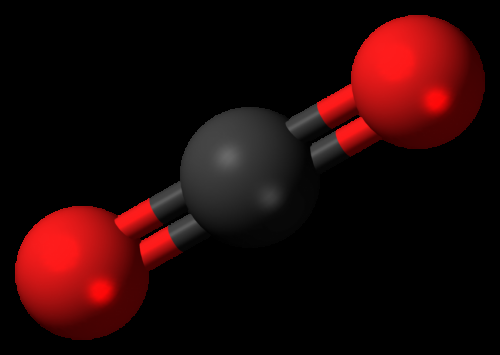June 3, 2015 report
Catalyst that converts carbon dioxide to carbon monoxide in water

(Phys.org)—Clean energy, or energy that comes from renewable sources, is of interest in the developing world. One path toward clean energy is harnessing solar energy and converting it into electrical energy, which could be done using a chemical process called Fischer-Tropsch. This process converts gaseous carbon monoxide and hydrogen into liquid hydrocarbons, which can then be used for fuel.
To take advantage of this potential source of fuel through the use of a renewable source, carbon dioxide, must be converted to carbon monoxide in a way that is industrially practical. This reaction requires a catalyst to obtain quantitative yields of carbon monoxide. Additionally, this reaction is typically done in non-aqueous solvents, which makes industrial-scale processes more difficult. Cyrille Costentin, Marc Robert, Jean-Michel Saveant, and Arnaud Tatin from the Laboratoire d'Electrochimie Moléculaire, Université Paris Diderot, Sorbonne Paris Cité, Unité Mixte de Recherche Université - CNRS have designed a catalyst that converts carbon dioxide to carbon monoxide in near-quantitative yields in water. This catalyst also allows for tunable production of carbon dioxide-to-hydrogen ratios by controlling the pH of the system. Their work appears in the Proceedings of the National Academy of Science.
The conversion of carbon dioxide to carbon monoxide requires a catalyst to prohibit the formation of an energetically unfavorable radical anion (CO2•-). Iron porphyrins are a desirable candidate for a catalyst because the iron can be reduction from Fe(I) to Fe(0) using electrochemistry. Fe(0) can then bind with the unwanted radical anion intermediate, allowing for the production of carbon monoxide. However, porphyrins are not water soluble. Furthermore, acid promotes the catalytic reaction, but the presence of acid also risks the formation of hydrogen gas. The formation of carbon monoxide and hydrogen gas are competitive and therefore, the more hydrogen gas that is produced, the lower the product yield of carbon monoxide.
Prior studies showed that phenols are a good candidate for providing an acidic proton while not promoting the formation of hydrogen gas. The authors decided to incorporate phenol groups into the porphyrin structure. However, the phenol-modified catalyst was still insoluble in water. To overcome this, Costentin, et al. incorporated a para-substituted trimethylamine into the phenol groups. This final product is a water soluble modified porphyrin.
Cyclic voltammetry studies of their catalyst in the absence of CO2 showed three waves, characteristics of iron's three oxidation states. The wave of interest is the one that represents the oxidation of Fe(I) to Fe(0). Fe(0) is necessary for catalyzing the CO2-to-CO reaction. Cyclic voltammetry studies of the catalyst in the presence of CO2 shows a large increase in current, indicating catalytic activity.
Cyclic voltammetric and preparative-scale electrolysis studies clarified the reaction mechanism and demonstrated the reaction's pH dependence. The first electrolysis study was over a four hour period in which CO2 was added to an aqueous solution of the catalyst at -0.97 V vs. NHE. The pH was increased using KOH. The resulting products showed CO as the predominant product (90%) with a small amount of H2 (7%) present, as well as other bi-products. A second study over a longer period of time but at potential of -0.87 V vs. NHE lead to a near-quantitative production of CO. Additional pH studies showed that at lower pH, more H2 forms.
While additional kinetic studies need to be done, the authors believe that at neutral pH CO formation is competitively favored over the formation of H2CO3 which leads to H2 production. While porphyrins typically catalyze H2 production, the production of H2CO3 is energetically unfavorable and kinetically slow with this particular catalyst.
Finally, Costentin, et al. estimated overpotential and turnover frequency of their catalyst using methods that they had previously reported in which overpotential and turnover frequency are related to each other via a catalytic Tafel plot. These plots allow comparison and analysis of catalysts based on intrinsic chemical properties while also minimizing the effects of side reactions. Using a catalytic Tafel plot, they were able to estimate a maximum turnover frequency for their catalyst at 107 s-1. Additionally, Tafel plots that compare their catalyst with other catalysts in aprotic solvents showed that their modified porphyrin is the best catalyst for this reaction.
While additional studies need to be done to understand the mechanism involved, Costentin, et al. report a novel catalyst that is able to convert CO2 to CO in near quantitative yields in a neutral aqueous environment. This finding is key step in the process of taking a renewable source, CO2, and converting it into a usable energy source.
More information: "Efficient and selective molecular catalyst for the CO2-to-CO electrochemical conversion in water" PNAS, DOI: 10.1073/pnas.1507063112
Abstract
Substitution of the four paraphenyl hydrogens of iron tetraphenylporphyrin by trimethylammonio groups provides a water-soluble molecule able to catalyze the electrochemical conversion of carbon dioxide into carbon monoxide. The reaction, performed in pH-neutral water, forms quasi-exclusively carbon monoxide with very little production of hydrogen, despite partial equilibration of CO2 with carbonic acid—a low pKa acid. This selective molecular catalyst is endowed with a good stability and a high turnover frequency. On this basis, prescribed composition of CO–H2 mixtures can be obtained by adjusting the pH of the solution, optionally adding an electroinactive buffer. The development of these strategies will be greatly facilitated by the fact that one operates in water. The same applies for the association of the cathode compartment with a proton-producing anode by means of a suitable separator.
Journal information: Proceedings of the National Academy of Sciences
© 2015 Phys.org



















